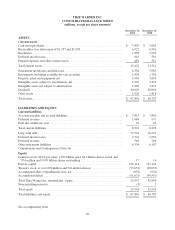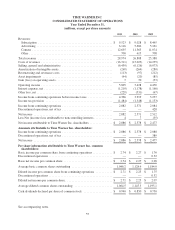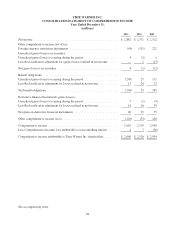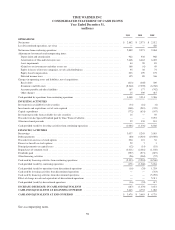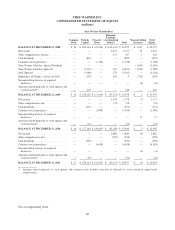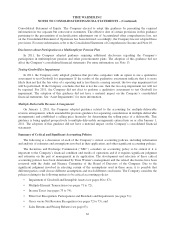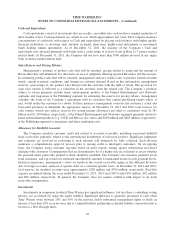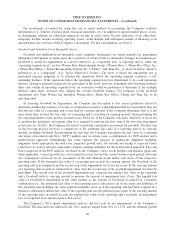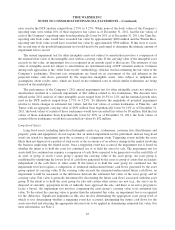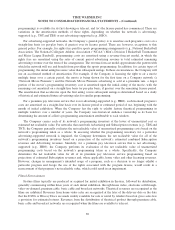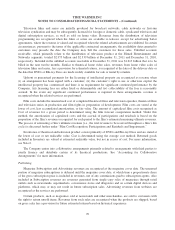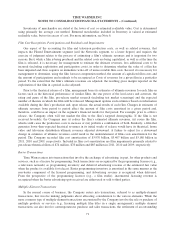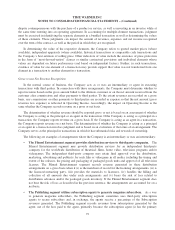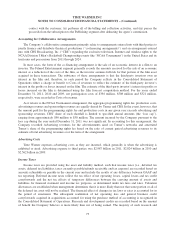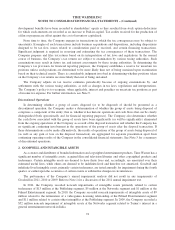Time Magazine 2011 Annual Report Download - page 78
Download and view the complete annual report
Please find page 78 of the 2011 Time Magazine annual report below. You can navigate through the pages in the report by either clicking on the pages listed below, or by using the keyword search tool below to find specific information within the annual report.TIME WARNER INC.
NOTES TO CONSOLIDATED FINANCIAL STATEMENTS – (Continued)
Under the equity method of accounting, only Time Warner’s investment in and amounts due to and from the
equity investee are included in the Consolidated Balance Sheet; only Time Warner’s share of the investee’s
earnings (losses) is included in the Consolidated Statement of Operations; and only the dividends, cash
distributions, loans or other cash received from the investee, additional cash investments, loan repayments or
other cash paid to the investee are included in the Consolidated Statement of Cash Flows. Additionally, the
carrying value of investments accounted for using the equity method of accounting is adjusted downward to
reflect any other-than-temporary declines in value (see “Asset Impairments” below).
Investments in companies in which Time Warner does not have a controlling interest or over which it is
unable to exert significant influence are accounted for at market value if the investments are publicly traded. If
the investment is not publicly traded, the investment is accounted for at cost. Unrealized gains and losses on
investments accounted for at market value are reported, net of tax, in Accumulated other comprehensive loss, net,
until the investment is sold or considered impaired (see “Asset Impairments” below), at which time the realized
gain or loss is included in Other loss, net. Dividends and other distributions of earnings from both market-value
investments and investments accounted for at cost are included in Other loss, net, when declared. For more
information, see Note 4.
Consolidation
Time Warner consolidates all entities in which it has a controlling voting interest and all variable interest
entities (“VIEs”) in which the Company is deemed to be the primary beneficiary. An entity is generally a VIE if
it meets any of the following criteria: (i) the entity has insufficient equity to finance its activities without
additional subordinated financial support from other parties, (ii) the equity investors cannot make significant
decisions about the entity’s operations or (iii) the voting rights of some investors are not proportional to their
obligations to absorb the expected losses of the entity or receive the expected returns of the entity and
substantially all of the entity’s activities involve or are conducted on behalf of the investor with
disproportionately few voting rights. Time Warner periodically makes judgments in determining whether entities
in which it invests are VIEs and, each reporting period, the Company assesses whether it is the primary
beneficiary in any of its VIEs. Entities determined to be VIEs primarily consist of the Company’s investments in
HBO Asia, HBO South Asia and HBO Latin America Group (“HBO LAG”) because the Company’s ownership
and voting rights in these entities are disproportionate. These entities operate multi-channel premium pay and
basic tier television services and are accounted for using the equity method. See Note 4 for additional
information.
Derivative Instruments
The Company uses derivative instruments principally to manage the risk associated with movements in
foreign currency exchange rates and recognizes all derivative instruments on the Consolidated Balance Sheet at
fair value. Changes in fair value of derivative instruments that qualify for hedge accounting will either be offset
against the change in fair value of the hedged assets, liabilities or firm commitments through earnings or
recognized in shareholders’ equity as a component of Accumulated other comprehensive loss, net, until the
hedged item is recognized in earnings, depending on whether the derivative instrument is being used to hedge
changes in fair value or cash flows. The ineffective portion of a derivative instrument’s change in fair value is
immediately recognized in earnings. For those derivative instruments that do not qualify for hedge accounting,
changes in fair value are recognized immediately in earnings. See Note 7 for additional information regarding
derivative instruments held by the Company and risk management strategies.
Property, Plant and Equipment
Property, plant and equipment are stated at cost. Additions to property, plant and equipment generally
include material, labor and overhead. Time Warner also capitalizes certain costs associated with coding, software
configuration, upgrades and enhancements incurred for the development of internal use software. Depreciation is
recorded on a straight-line basis over estimated useful lives. Upon the occurrence of certain events or
circumstances, Time Warner evaluates the depreciation periods of property, plant and equipment to determine
64




